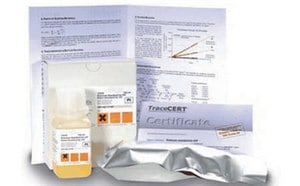Atomic Spectroscopy Overview

Atomic spectroscopy uses the electromagnetic radiation or mass spectrum of a sample to determine elemental composition. The wavelength of energy absorbed or emitted by atoms is characteristic to each element and can be used for element identification and quantification.
Analytical techniques based on atomic spectroscopy are widely used in environmental chemistry, geology and soil science, mining and metallurgy, food sciences, and medicine.
Featured Categories
Enhance inorganic trace analysis with our certified AAS and ICP standards. NIST-traceable solutions available.
Browse through our selection of reference materials of inorganic elemental impurity mixes as per ICHQ3D guidelines for your ICP or AAS based tests of drug products in pharmaceutical analysis.
Uncover a wide acid range: Supelco® for analysis, Sigma-Aldrich® for labs, SAFC® for biopharma. Tailor solutions for varied needs.
Milli-Q® systems offer innovative water purification technologies engineered to support lab research needs, sustainability goals, and other major requirements.
Atomic absorption spectroscopy (AAS)
Atomic absorption spectroscopy (AAS) works by measuring the amount of UV/visible light energy absorbed by an element. The wavelength of light absorbed corresponds to the energy needed to promote its electrons from the ground state to a higher energy level. The amount of energy absorbed in this excitation process is proportional to the concentration of the element in the sample.
Flame atomic absorption spectroscopy (FAA)
Flame atomic absorption spectroscopy (FAA) involves vaporization and thermal atomization of a liquid sample by a flame. In this technique, a sample solution is aspirated and sprayed as a fine aerosol into a chamber to combine with fuel and oxidant gases. The resulting mixture is then carried to the burner head, where combustion and sample atomization occurs.
Graphite furnace atomic absorption spectroscopy (GFAA)
Graphite furnace atomic absorption spectroscopy (GFAA) is the most advanced and sensitive technique to assess atomic absorption. With a graphite furnace atomizer, the atoms are retained in the optical path for a slightly longer time compared with flame atomization, resulting in lower detection limits and sensitivity in the parts per billion (ppb) range.
Inductively coupled plasma optical emission spectroscopy (ICP-OES)
Inductively coupled plasma optical emission spectroscopy (ICP-OES) measures the light emitted by excited electrons of an element while returning to their stable ground state. The sample is introduced into an argon plasma and high temperature excites the atom’s electrons to higher energy levels. The element is identified by the characteristic wavelength of the light emitted as its electrons return to ground state. The intensity of the light emitted is related to the concentration of the element in the sample.
Inductively coupled plasma-mass spectrometry (ICP-MS)
Inductively coupled plasma mass spectrometry (ICP-MS) is a type of mass spectrometry used for the highly sensitive quantification of various metals and non-metals in the concentration range of below 1 part per trillion (ppt). ICP-MS analyzes elements by their separation in a magnetic field as per their mass to charge (m/z) ratio.
X-ray fluorescence (XRF) spectrometry
X-ray fluorescence (XRF) spectrometry detects elemental composition by measuring the wavelength and intensity of X-rays emitted by energized atoms in a sample. In this method, a beam of short wavelength x-rays strikes the sample and dislodges innermost shell electrons of the atom, forming a vacant site or “hole”. This causes the atom to rearrange its electronic arrangement with an electron from a higher energy shell jumping to occupy the newly created vacancy and emitting characteristic X-ray light during the process. The X-rays emitted by the atoms during the process of fluorescence are detected and used for sample identification and quantitation.
Visit our document search for data sheets, certificates and technical documentation.
Related Articles
- Elemental impurities in pharmaceutical drugs present a risk to human health and are regulated. Milli-Q® ultrapure water purification systems comply with the requirements for trace element analyses.
- Elemental impurities in pharmaceutical products must be monitored and controlled at all stages of development and production. Ultrapure water produced by a Milli-Q® water system is recommended for ICP-MS and ICP-OES trace element analyses.
- Control elemental impurities in drug products with analytical methods and materials to ensure patient safety.
- See the data showing how Milli-Q® ultrapure water meets the stringent purity requirements for reliable trace element analyses of environmental samples.
- Essential steps to identifying your optimal water system. From quality to greener technologies & space saving options.
- See All (9)
Related Protocols
- View instructional videos and download User Manuals for Milli-Q® SQ 2Series lab water systems. You’ll be up and running in no time. Buy online systems, accessories, cartridges and services.
Find More Articles and Protocols
How Can We Help
In case of any questions, please submit a customer support request
or talk to our customer service team:
Email custserv@sial.com
or call +1 (800) 244-1173
Additional Support
- Chromatogram Search
Use the Chromatogram Search to identify unknown compounds in your sample.
- Calculators & Apps
Web Toolbox - science research tools and resources for analytical chemistry, life science, chemical synthesis and materials science.
- Customer Support Request
Customer support including help with orders, products, accounts, and website technical issues.
- FAQ
Explore our Frequently Asked Questions for answers to commonly asked questions about our products and services.
To continue reading please sign in or create an account.
Don't Have An Account?



